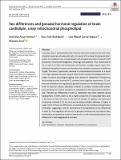Por favor, use este identificador para citar o enlazar a este item:
http://hdl.handle.net/10261/206298COMPARTIR / EXPORTAR:
 SHARE SHARE
 CORE
BASE CORE
BASE
|
|
| Visualizar otros formatos: MARC | Dublin Core | RDF | ORE | MODS | METS | DIDL | DATACITE | |

| Título: | Sex differences and gonadal hormone regulation of brain cardiolipin, a key mitochondrial phospholipid |
Autor: | Acaz-Fonseca, E. CSIC ORCID; Ortiz-Rodriguez, Ana CSIC ORCID; García-Segura, Luis M. CSIC ORCID; Astiz, Mariana CSIC ORCID | Palabras clave: | Brain development Cardiolipin Mitochondria Sex differences testosterone |
Fecha de publicación: | 2019 | Citación: | Journal of Neuroendocrinology (2019) | Resumen: | Cardiolipin (CL) is a phospholipid that is almost exclusively located in the inner mitochondrial membrane of eukaryotic cells. As a result of its unique structure and distribution, CL establishes non-covalent bonds with a long list of proteins involved in ATP production, mitochondria biogenesis, mitophagy and apoptosis. Thus, the amount of CL, as well as its fatty acid composition and location, strongly impacts upon mitochondrial-dependent functions and therefore the metabolic homeostasis of different tissues. The brain is particularly sensitive to mitochondrial dysfunction as a result of its high metabolic demand. Several mitochondrial related-neurodegenerative disorders, as well as physiological ageing, show altered CL metabolism. Furthermore, mice lacking enzymes involved in CL synthesis show cognitive impairments. CL content and metabolism are regulated by gonadal hormones in the developing and adult brain. In neuronal cultures, oestradiol increases CL content, whereas adult ovariectomy decreases CL content and alters CL metabolism in the hippocampal mitochondria. Transient sex differences in brain CL metabolism have been detected during development. At birth, brain CL has a higher proportion of unsaturated fatty acids in the brain of male mice than in the brain of females. In addition, the expression of enzymes involved in CL de novo and recycling synthetic pathways is higher in males. Most of these sex differences are abolished by the neonatal androgenisation of females, suggesting a role for testosterone in the generation of sex differences in brain CL. The regulation of brain CL by gonadal hormones may be linked to their homeostatic and protective actions in neural cells, as well as the manifestation of sex differences in neurodegenerative disorders. | Versión del editor: | http://dx.doi.org/10.1111/jne.12774 | URI: | http://hdl.handle.net/10261/206298 | DOI: | 10.1111/jne.12774 | Identificadores: | doi: 10.1111/jne.12774 issn: 1365-2826 |
| Aparece en las colecciones: | (IC) Artículos |
Ficheros en este ítem:
| Fichero | Descripción | Tamaño | Formato | |
|---|---|---|---|---|
| Sex differences and gonadal hormone regulation of brain cardiolipin, a key mitochondrial phospholipid.pdf | 774,88 kB | Adobe PDF |  Visualizar/Abrir |
CORE Recommender
SCOPUSTM
Citations
8
checked on 30-mar-2024
WEB OF SCIENCETM
Citations
7
checked on 27-feb-2024
Page view(s)
108
checked on 15-abr-2024
Download(s)
108
checked on 15-abr-2024
Google ScholarTM
Check
Altmetric
Altmetric
Este item está licenciado bajo una Licencia Creative Commons

